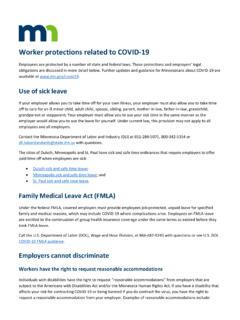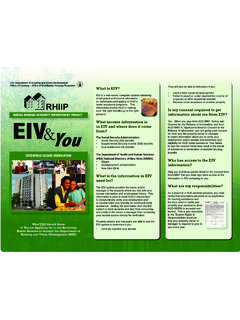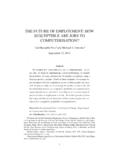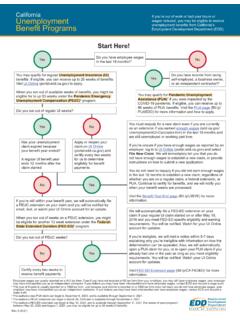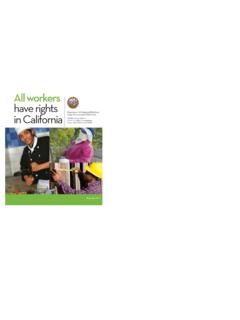Transcription of Notice 931 (Rev. September 2021) - IRS tax forms
1 Userid: CPMS chema: noticeLeadpct: 100%Pt. size: 10 Draft Ok to PrintAH XSL/XMLF ileid: .. ces/N931/201810/A/XML/Cycle03/source(Ini t. & Date) _____Page 1 of 4 9:55 - 28-Aug-2018 The type and rule above prints on all proofs including departmental reproduction proofs. MUST be removed before 931(Rev. October 2018)Department of the TreasuryInternal Revenue ServiceDeposit Requirements for employment TaxesThere are two deposit schedules monthly or semiweekly for determining when you deposit social security and Medicare taxes and withheld federal income tax. These schedules tell you when a deposit is due after a tax liability arises (for example, when you have a payday). Before the beginning of each calendar year, you must determine which of the two deposit schedules you must use. The deposit schedule you must use is based on the total tax liability you reported during a lookback period.
2 Your deposit schedule isn't determined by how often you pay your employees or make deposits. See Application of Monthly and Semiweekly Schedules, rules don't apply to federal unemployment (FUTA) tax. See the Instructions for form 940 for information on depositing FUTA rules for form 941. Your deposit schedule (monthly or semiweekly) for form 941, Employer's QUARTERLY Federal Tax Return, is based on the total tax liability you reported on forms 941 during a 4-quarter lookback period discussed later under Lookback period for form of making deposits during the current quarter, you can pay your total form 941 tax liability when you timely file form 941 total form 941 tax liability for either the current quarter or the preceding quarter is less than $2,500, don't incur a $100,000 next-day deposit obligation during the current you re not sure your total liability for the current quarter will be less than $2,500, and your liability for the preceding quarter wasn't less than $2,500, make deposits using the semiweekly or monthly rules so you won't be subject to failure-to-deposit penalties.
3 For more information about deposit rules for form 941, see section 11 of Pub. rules for annual forms 943, 944, 945, and CT-1. Generally, the deposit rules for quarterly filers of form 941 also apply to annual filers of form 943, Employer's Annual Federal Tax Return for Agricultural Employees; form 944, Employer's ANNUAL Federal Tax Return; form 945, Annual Return of Withheld Federal Income Tax; and form CT-1, Employer's Annual Railroad Retirement Tax Return. However, the period used as your lookback period is different; see Lookback period for annual returns, later. For more information about deposit rules for annual returns, see section 11 of Pub. 15 (for forms 944 and 945), section 7 of Pub. 51 (for form 943), and the Instructions for form tax deposits must be made by electronic funds transfer (EFT).
4 You must use EFT to make all federal tax deposits. Generally, an EFT is made using the Electronic Federal Tax Payment System (EFTPS). If you don't want to use EFTPS, you can arrange for your tax professional, financial institution, payroll service, or other trusted third party to make electronic deposits on your behalf. Also, you may arrange for your financial institution to initiate a same-day wire payment on your behalf. EFTPS is a free service provided by the Department of Treasury. Services provided by your tax professional, financial institution, payroll service, or other third party may have a more information on making federal tax deposits, see section 11 of Pub. 15. To get more information about EFTPS or to enroll in EFTPS, visit or call 800-555-4477 or 800-733-4829 (TDD).
5 Additional information about EFTPS is also available in Pub. on time. For EFTPS deposits to be on time, you must submit the deposit by 8 Eastern time the day before the date the deposit is due. If you fail to submit an EFTPS deposit on time, you may use the same-day wire payment option discussed period for form 941. Your deposit schedule for a calendar year is determined from the total taxes reported on your forms 941 in a 4-quarter lookback period. The lookback period begins July 1 and ends June 30, as shown in the following chart. If you reported $50,000 or less of form 941 taxes for the lookback period, you re a monthly schedule depositor; if you reported more than $50,000, you re a semiweekly schedule depositor. The lookback period for a 2019 form 941 filer who filed form 944 in either 2017 or 2018 is calendar year 941 Lookback Period for Calendar Year 2019 Lookback Period201720182019 July 1 through Sept.
6 30 Oct. 1 through Dec. 31 Jan. 1 through Mar. 31 Apr. 1 through June 30 Calendar YearJan. period for annual returns. For annual returns ( forms 943, 944, 945, and CT-1), the lookback period is the calendar year preceding the previous year. For example, the lookback period for 2019 is No. 14736 TPage 2 of 4 Fileid: .. ces/N931/201810/A/XML/Cycle03/source9:55 - 28-Aug-2018 The type and rule above prints on all proofs including departmental reproduction proofs. MUST be removed before Deposit ScheduleYou re a monthly schedule depositor for a calendar year if the total tax reported for your lookback period was $50,000 or the monthly deposit schedule, deposit accumulated taxes on payments made during a calendar month by the 15th day of the following employers. Your tax liability for any quarter in the lookback period before the date you started or acquired your business is considered to be zero.
7 Therefore, you re a monthly schedule depositor for the first calendar year of your business. However, see the $100,000 Next-Day Deposit Rule, Deposit ScheduleYou re a semiweekly schedule depositor for a calendar year if the total taxes during your lookback period were more than $50, Period (Payment Days)Deposit ByWednesday, Thursday, and/or FridayFollowing WednesdaySaturday, Sunday, Monday, and/or TuesdayFollowing FridaySemiweekly deposit period spanning two return periods. The period of time covered by a return is the return period. The return period for a quarterly form 941 is a calendar quarter. The return period for annual forms 943, 944, 945, and CT-1 is a calendar year. If a return period ends on a day other than Friday or Tuesday, taxes accumulated on the days during the return period just ending are subject to one deposit obligation, and taxes accumulated on the days covered by the new return period are subject to a separate deposit obligation.
8 For example, if a return period ends on Thursday, taxes accumulated on Wednesday and Thursday are subject to one deposit obligation and taxes accumulated on Friday are subject to a separate obligation. Separate deposits are required because two different return periods are of Monthly and Semiweekly SchedulesHazel Jones reported form 941 tax liabilities as follows:2018 Lookback Period2019 Lookback Period3rd Quarter 2016 $12,0003rd Quarter 2017 $12,0004th Quarter 2016 $12,0004th Quarter 2017 $12,0001st Quarter 2017 $12,0001st Quarter 2018 $12,0002nd Quarter 2017 $12,0002nd Quarter 2018 $15,000$48,000$51,000 Hazel is a monthly schedule depositor for 2018 because her tax liability for the 4 quarters in the lookback period (3rd quarter 2016 through 2nd quarter 2017) wasn't more than $50,000.
9 However, for 2019, Hazel is a semiweekly schedule depositor because her liability exceeded $50,000 for the 4 quarters in the lookback period (3rd quarter 2017 through 2nd quarter 2018).Deposits Due on Business Days OnlyIf a deposit is due on a day that isn't a business day, the deposit is considered to have been made timely if it is made by the close of the next business day. A business day is any day other than a Saturday, Sunday, or legal holiday. For example, if a deposit is due on a Friday and Friday is a legal holiday, the deposit will be considered timely if it is made by the following Monday (if that Monday is a business day). The term "legal holiday" means any legal holiday in the District of Columbia. For a list of legal holidays, see section 11 of Pub. 15 or section 7 of Pub.
10 Schedule depositors have at least 3 business days following the close of the semiweekly period to make a deposit. That is, if any of the 3 weekdays after the end of a semiweekly period is a legal holiday, you ll have an additional business day to deposit for each day that is a legal holiday. For example, if a semiweekly schedule depositor accumulated taxes for payments made on Friday and the following Monday is a legal holiday, the deposit normally due on Wednesday may be made on Thursday. This allows 3 business days to make the of Monthly and Semiweekly SchedulesThe terms monthly schedule depositor and semiweekly schedule depositor don't refer to how often your business pays its employees or even to how often you must make deposits. The terms identify which set of deposit rules you must follow when an employment tax liability arises.










